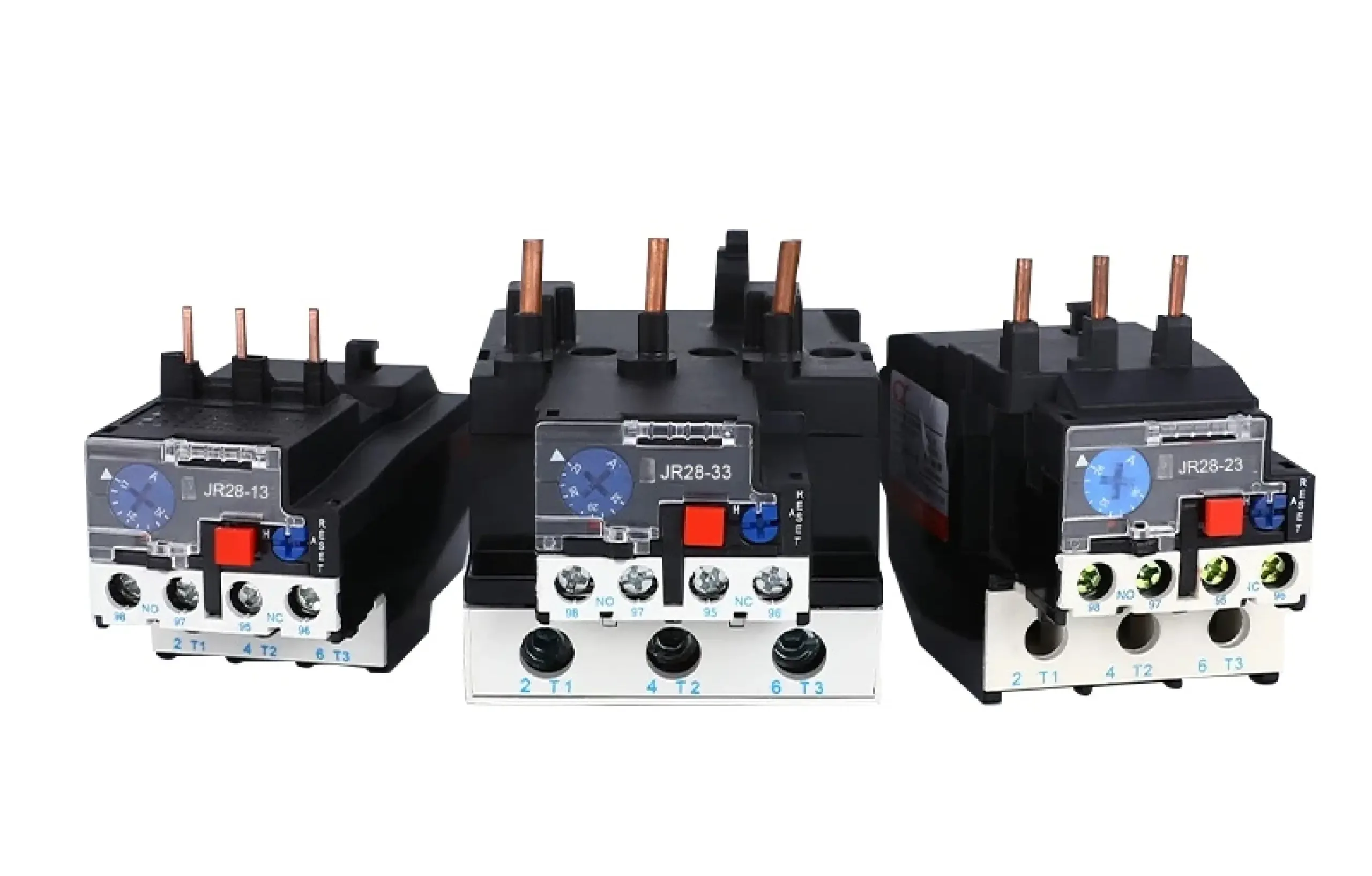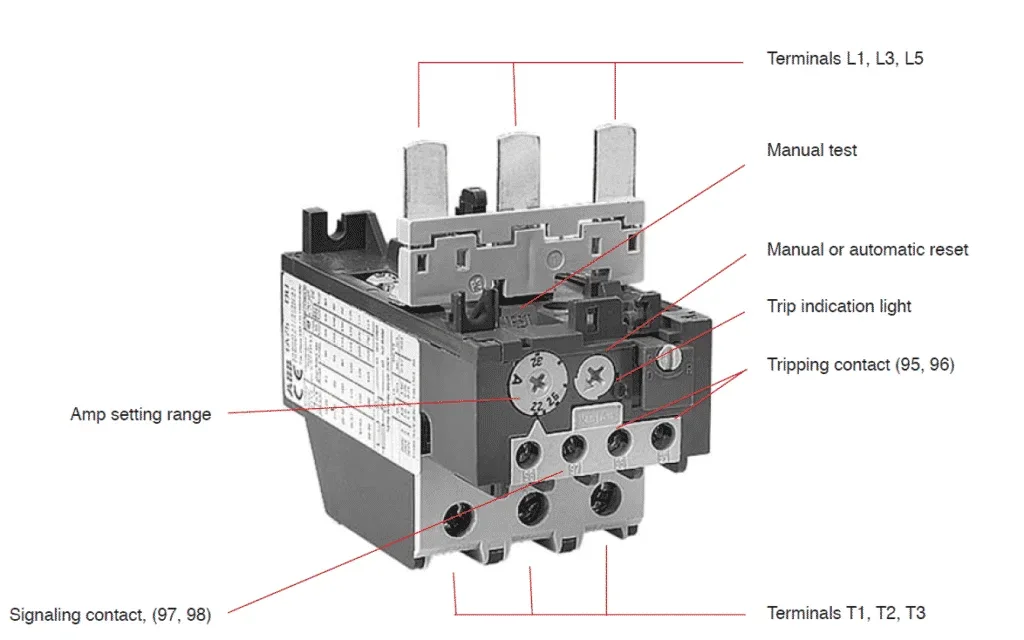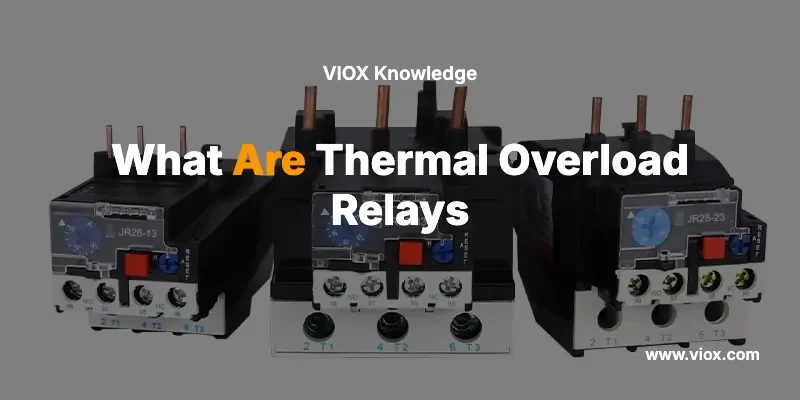Kurz gesagt: Thermische Überlastrelais sind wichtige Motorschutzgeräte, die eine Überhitzung elektrischer Geräte verhindern, indem sie den Stromfluss überwachen und die Stromzufuhr bei anhaltender Überlastung automatisch unterbrechen. Sie sind kostengünstig, zuverlässig und werden häufig in industriellen Anwendungen eingesetzt, um Motoren, Transformatoren und andere elektrische Geräte vor Schäden zu schützen.
Grundlegendes zu thermischen Überlastrelais

Ein thermisches Überlastrelais ist eine spezielle Schutzvorrichtung, die Elektromotoren und Stromkreise vor Schäden durch anhaltende Überströme schützt. Im Gegensatz zu Leistungsschaltern, die sofortigen Schutz bieten, arbeiten thermische Überlastrelais nach dem Zeitverzögerungsprinzip und ermöglichen so vorübergehende Überlastungen (z. B. Motoranlaufströme) und schützen gleichzeitig vor dauerhaft gefährlichen Bedingungen.
Diese Geräte überwachen den Stromfluss zu angeschlossenen Geräten und erkennen mithilfe thermischer Sensortechnologie, wann die Betriebsbedingungen sichere Parameter überschreiten. Hält eine Überlastung lange genug an, um möglicherweise Schäden zu verursachen, löst das Relais automatisch aus und unterbricht die Stromzufuhr zum Schutz des Geräts.
Funktionsweise thermischer Überlastrelais
Grundlegendes Funktionsprinzip
Die Funktionsprinzip des thermischen Überlastrelais Der Schwerpunkt liegt auf der thermischen Reaktion auf übermäßigen Stromfluss. Steigt der Strom über den normalen Betriebspegel, erzeugen Heizelemente im Relais entsprechende Wärme. Diese Wärme beeinflusst eine temperaturempfindliche Komponente, die den Schutzmechanismus auslöst, wenn vorgegebene Schwellenwerte überschritten werden.
Der Vorteil dieses Designs liegt in seiner Fähigkeit, zwischen harmlosen, vorübergehenden Überlastungen und gefährlichen, anhaltenden Zuständen zu unterscheiden. Motoren ziehen beim Anlauf naturgemäß höhere Ströme – oft 600% oder mehr ihres Nennstroms –, aber thermische Überlastrelais ermöglichen diese kurzen Stromstöße und schützen gleichzeitig vor dauerhaften Überlastungen, die zu Geräteschäden führen.
Wichtige Komponenten

Kredit an Electricalclassroom
Moderne thermische Überlastrelais enthalten mehrere wesentliche Komponenten, die zusammenarbeiten:
- Temperatursensorelement: Typischerweise handelt es sich um einen Bimetallstreifen aus zwei verschiedenen Metallen mit unterschiedlicher Wärmeausdehnung. Wird dieses Element durch Strom erhitzt, führt die unterschiedliche Ausdehnung dazu, dass sich der Streifen verbiegt und schließlich den Relaismechanismus auslöst.
- Heizelemente: Diese Komponenten leiten den Motorstrom und erzeugen proportional zum Stromfluss Wärme. Je nach Motorleistung können unterschiedliche Heizelemente ausgewählt werden.
- Auslösemechanismus: Ein mechanisches System aus Hebeln und Kontakten, das sich öffnet, wenn das Sensorelement eine Überlastung anzeigt.
- Rücksetzmechanismus: Entweder manuell oder automatisch, sodass das Relais nach dem Abkühlen und der Fehlerbehebung wieder in den Normalbetrieb zurückkehren kann.
- Hilfskontakte: Normalerweise offene (NO) und normalerweise geschlossene (NC) Kontakte für Signalisierung, Alarme oder Steuerkreisintegration.
Arten von thermischen Überlastrelais
Bimetallische thermische Überlastrelais
Bimetallische thermische Überlastrelais stellen den häufigsten Typ dar und bestehen aus zwei miteinander verbundenen unterschiedlichen Metallen. Diese Metalle – typischerweise Stahl und eine Legierung mit unterschiedlichen Ausdehnungskoeffizienten – verbiegen sich, wenn sie durch übermäßigen Stromfluss erhitzt werden.
Vorteile:
- Kostengünstig und zuverlässig
- Einfache Konstruktion mit weniger Schwachstellen
- Geeignet für die meisten Allzweckanwendungen
- Temperaturkompensation in fortgeschrittenen Modellen verfügbar
Typische Anwendungen: HVAC-Systeme, Pumpen, Förderbänder, allgemeine Industriemotoren
Elektronische thermische Überlastrelais
Elektronische thermische Überlastrelais Verwenden Sie anstelle mechanischer Thermoelemente hochentwickelte elektronische Schaltungen zur Stromüberwachung und Berechnung thermischer Effekte. Diese Geräte bieten höchste Genauigkeit und zusätzliche Funktionen.
Wichtigste Vorteile:
- Höhere Präzision und Wiederholgenauigkeit
- Unempfindlich gegenüber Änderungen der Umgebungstemperatur
- Zusätzliche Schutzfunktionen (Phasenausfall, Spannungsungleichgewicht)
- Diagnosefunktionen und Kommunikationsoptionen
- Schnellere Reaktionszeiten für kritische Anwendungen
Erweiterte Funktionen: Viele elektronische Modelle liefern Echtzeitdaten, darunter den Prozentsatz der thermischen Kapazitätsauslastung (%TCU), Auslösezeitberechnungen und Erdschlusserkennung.
Eutektische thermische Überlastrelais
Eutektische thermische Überlastrelais Sie verwenden eine spezielle Legierung, die bei einer genau definierten Temperatur schmilzt. Wenn sich die Legierung aufgrund übermäßiger Hitze verflüssigt, wird ein mechanischer Auslöser freigesetzt, der die Relaiskontakte öffnet.
Diese Relais sind heute weniger verbreitet, werden aber immer noch in bestimmten Anwendungen eingesetzt, die sehr präzise Auslösepunkte und eine hervorragende Wiederholbarkeit erfordern.
Thermisches Überlastrelais vs. Leistungsschalter
Verstehen, wann man es verwenden sollte thermische Überlastrelais versus Stromkreisunterbrecher ist entscheidend für einen guten Motorschutz:
Leistungsschaltereigenschaften
- Bietet sowohl Überlast- als auch Kurzschlussschutz
- Muss überdimensioniert sein, um Anlaufströme des Motors zu ermöglichen
- Magnetisches Auslöseelement für sofortigen Kurzschlussschutz
- Thermoelement für langsameren Überlastschutz
Vorteile des thermischen Überlastrelais
- Präziserer Überlastschutz: Kann exakt auf die Volllaststromstärke des Motors eingestellt werden
- Besser geeignet für Motoreigenschaften: Speziell für den thermischen Motorschutz entwickelt
- Kostengünstig: Günstiger als Motorschutzschalter
- Flexible Installation: Kann direkt auf Schütze montiert werden
Wann sind sie zu verwenden?
- Leistungsschalter: Wenn Sie kombinierten Kurzschluss- und Überlastschutz in einem Gerät benötigen
- Thermische Überlastrelais: Wenn ein präziser Motorschutz erforderlich ist, wird er typischerweise mit einem separaten vorgeschalteten Kurzschlussschutz verwendet.
Reiseklassen und Zeitmerkmale
Thermische Überlastrelais werden klassifiziert nach ihrer Reiseklasse, die die Reaktionszeit unter Überlastbedingungen definiert:
- Klasse 5: Extrem schnell (5 Sekunden bei 7,2-fachem Nennstrom) – für Anwendungen mit schneller Reaktion
- Klasse 10: Standardmäßige Industrieanwendungen (10 Sekunden bei 7,2-fachem Nennstrom)
- Klasse 20: Allzweckmotoren (20 Sekunden bei 7,2-fachem Nennstrom)
- Klasse 30: Lasten mit hoher Trägheit wie Lüfter und Schwungräder (30 Sekunden bei 7,2-fachem Nennstrom)
Die inverse Zeitcharakteristik bedeutet, dass höhere Überlastungen eine schnellere Auslösung bewirken und sowohl vor mäßigen, anhaltenden Überlastungen als auch vor schweren kurzfristigen Bedingungen schützen.
Anwendungen und Branchen
Industrieller Motorschutz
Thermische Überlastrelais schützen Motoren in unzähligen industriellen Anwendungen:
- Pumpen und Kompressoren
- Förderanlagen und Materialhandhabung
- HVAC-Lüfter und -Gebläse
- Werkzeugmaschinen und Automatisierungsgeräte
Kommerzielle Anwendungen
- Gebäude-HVAC-Systeme
- Aufzugsmotoren
- Kommerzielle Küche Ausrüstung
- Kältekompressoren
Spezialanwendungen
- Öl- und Gasausrüstung
- Bergbaumaschinen
- Schiffsantriebssysteme
- Ausrüstung für die Prozessindustrie
Installation und Verdrahtung Richtlinien
Richtige Dimensionierung
Wählen Sie thermische Überlastrelais mit Strombereichen, die die Volllaststromstärke (FLA) des Motors umfassen. Stellen Sie den Auslösepunkt so ein, dass er der Volllaststromstärke auf dem Motortypenschild entspricht, typischerweise innerhalb von ±10%.
Verdrahtung Konfiguration
Thermische Überlastrelais werden in Reihe mit dem Motorstromkreis geschaltet und üblicherweise direkt auf Schützen montiert. Die Hilfskontakte des Relais sind mit dem Steuerstromkreis des Schützes verbunden und sorgen so bei Überlastung für eine Stromunterbrechung.
Wichtige Überlegungen
- Installieren Sie immer einen vorgeschalteten Kurzschlussschutz
- Sorgen Sie für ausreichende Belüftung rund um Thermorelais
- Berücksichtigen Sie die Auswirkungen der Umgebungstemperatur auf nicht kompensierte Modelle
- Überprüfen Sie die Kompatibilität zwischen Relais- und Schützmodellen
Rücksetzmechanismen: Manuell vs. Automatisch
Manueller Reset
Manuell zurücksetzbare thermische Überlastrelais erfordern einen Eingriff des Bedieners, um den Betrieb nach einer Auslösung wiederherzustellen. Dieser Ansatz gewährleistet:
- Untersuchung der Überlastungsursachen vor dem Neustart
- Bewusstsein des Bedieners für Systemprobleme
- Verhinderung wiederholter automatischer Neustarts, die Fehler verschlimmern könnten
Automatisches Zurücksetzen
Thermische Überlastrelais mit automatischer Rückstellung Automatische Wiederherstellung des Betriebs nach Abkühlphasen. Vorteile:
- Reduzierter Wartungsaufwand
- Geeignet für abgelegene oder unbemannte Standorte
- Schnellere Wiederherstellung bei vorübergehender Überlastung
Treffen Sie Ihre Auswahl auf Grundlage der Anwendungsanforderungen, Sicherheitsaspekte und Betriebspräferenzen.
Behebung Häufig Auftretender Probleme
Häufiges Fehlstolpern
Mögliche Ursachen:
- Relais für tatsächlichen Motorstrom zu niedrig eingestellt
- Hohe Umgebungstemperatur beeinflusst das Relais
- Motor läuft unter Überlastungsbedingungen
- Lose Anschlüsse verursachen Spannungsabfall
Lösungen:
- Aktuelle Einstellungen überprüfen und anpassen
- Verbessern Sie die Belüftung oder wählen Sie temperaturkompensierte Relais
- Untersuchen Sie die Motorbelastungsbedingungen
- Alle Verbindungen prüfen und festziehen
Fehlende Auslösung bei tatsächlicher Überlastung
Mögliche Ursachen:
- Relaisstromeinstellung zu hoch
- Defektes Thermoelement
- Kontakte verschweißt oder festgeklebt
- Unsachgemäße Verkabelung
Lösungen:
- Aktuelle Einstellungen auf Motortypenschild neu kalibrieren
- Testen Sie die Funktion des Relais mit der Testtaste
- Ersetzen Sie das Relais, wenn ein mechanischer Fehler erkannt wird
- Überprüfen Sie die ordnungsgemäße Reihenschaltung mit dem Motor
Vorteile des thermischen Überlastschutzes
Wirtschaftliche Vorteile
- Geringere Kosten als hochentwickelter elektronischer Schutz
- Reduzierte Motoraustauschkosten durch effektiven Schutz
- Minimierte Produktionsausfallzeiten durch Motorausfälle
- Einfache Wartung
Technische Vorteile
- Speziell für die thermischen Eigenschaften des Motors entwickelt
- Die eingebaute Zeitverzögerung verhindert Fehlauslösungen
- Kompatibel mit bestehenden Schützsystemen
- Zuverlässiger Betrieb in rauen Industrieumgebungen
Sicherheitsvorteile
- Verhindert eine Überhitzung des Motors und mögliche Brände
- Schützt das Personal vor Geräteausfällen
- Reduziert das Risiko kaskadierender Systemausfälle
- Verbessert die Gesamtzuverlässigkeit des elektrischen Systems
Wartung und bewährte Praktiken
Regelmäßige Inspektion
- Überprüfen Sie vierteljährlich, ob die Stromeinstellungen korrekt sind.
- Testbetrieb über eingebaute Testtasten
- Auf Anzeichen von Überhitzung oder Beschädigung prüfen
- Sichere Montage und Anschlüsse prüfen
Richtlinien zum Austausch
- Ersetzen Sie Relais, die Anzeichen einer Kontaktverschlechterung aufweisen
- Aktualisierung der elektronischen Typen für verbesserte Genauigkeit bei der Aktualisierung von Systemen
- Halten Sie Ersatzrelais für kritische Anwendungen bereit
- Dokumentieren Sie die Einstellungen und den Fahrtverlauf
Zukünftige Trends und Technologien
Intelligenter Wärmeschutz
Moderne elektronische thermische Überlastrelais bieten zunehmend:
- Kommunikationsfähigkeiten (Modbus, Ethernet/IP)
- Erweiterte Diagnose- und vorausschauende Wartungsfunktionen
- Integration mit Anlagenautomatisierungssystemen
- Cloudbasierte Überwachung und Analyse
Industrie 4.0 Integration
Der Wärmeschutz entwickelt sich weiter, um Initiativen zur intelligenten Fertigung zu unterstützen, und zwar durch:
- Leistungsüberwachung in Echtzeit
- Prädiktive Fehleranalyse
- Remote-Konfiguration und -Verwaltung
- Integration mit Energiemanagementsystemen
Fazit
Thermische Überlastrelais sind nach wie vor unverzichtbare Komponenten moderner elektrischer Anlagen. Sie bieten kostengünstigen und zuverlässigen Motorschutz, der Geräteschäden verhindert und die Betriebssicherheit gewährleistet. Das Verständnis ihrer Funktionsweise, die richtige Auswahl und Installation gewährleisten optimalen Schutz für wertvolle elektrische Geräte.
Ob herkömmliche Bimetallrelais für allgemeine Anwendungen oder moderne elektronische Modelle für kritische Systeme – thermische Überlastrelais bieten bewährten Schutz, der sich mit dem technologischen Fortschritt stetig weiterentwickelt. Ihre Fähigkeit, zwischen normalen Betriebsschwankungen und gefährlichen Überlastbedingungen zu unterscheiden, macht sie für den Motorschutz in unzähligen Anwendungen weltweit unverzichtbar.
Für die meisten Motorschutzanwendungen bieten thermische Überlastrelais das ideale Gleichgewicht zwischen Kosten, Zuverlässigkeit und Leistung – und sind daher die bevorzugte Wahl für Ingenieure und Techniker, die einen effektiven Schutz für elektrische Geräte suchen.
Häufig gestellte Fragen (FAQ)
Wie funktionieren thermische Überlastrelais genau?
Thermische Überlastrelais überwachen den zu einem Motor fließenden Strom und erzeugen mithilfe von Heizelementen Wärme proportional zum Strom. Überschreitet der Strom dauerhaft den sicheren Wert, erkennt ein Bimetallstreifen (bei thermischen Typen) oder ein elektronischer Sensor die überschüssige Wärme und löst einen Mechanismus aus, der Kontakte öffnet und die Stromzufuhr unterbricht, um Motorschäden zu verhindern.
Was ist der Unterschied zwischen thermischen Überlastrelais und Leistungsschaltern?
Stromkreisunterbrecher bieten sowohl Kurzschluss- als auch Überlastschutz, müssen jedoch überdimensioniert sein, um Anlaufströme des Motors zu ermöglichen, wodurch sie für den Motorschutz weniger präzise sind. Thermische Überlastrelais sind speziell auf die thermischen Eigenschaften des Motors ausgelegt und bieten einen präziseren Überlastschutz, erfordern jedoch einen separaten vorgeschalteten Kurzschlussschutz.
Warum löst mein thermisches Überlastrelais ständig aus?
Zu den häufigsten Ursachen gehören:
- Falsche Stromeinstellung: Relais für tatsächlichen Motorstrom zu niedrig eingestellt
- Hohe Umgebungstemperatur: Auswirkungen auf nicht kompensierte Relais
- Motorprobleme: Lagerprobleme, Fehlausrichtung oder tatsächliche Überlastungsbedingungen
- Lose Anschlüsse: Verursacht Spannungsabfall und erhöhten Strom
- Phasenungleichgewicht: Ungleichmäßige Stromverteilung in Dreiphasensystemen
Wie teste ich ein thermisches Überlastrelais?
Mit der Testtaste: Drücken Sie die rote Testtaste, um eine Überlastung zu simulieren. Die Auslöseanzeige sollte aufleuchten und die Kontakte sollten ihren Zustand ändern.
Mit einem Multimeter: Testen Sie bei ausgeschalteter Stromversorgung die Kontinuität zwischen den Hauptkontakten (sollte 0 Ohm anzeigen) und den Hilfskontakten (NO-Kontakte sollten „offener Stromkreis/OL“ anzeigen, NC-Kontakte sollten Kontinuität anzeigen).
Stromeinspeisungstest: Für präzise Tests geben Sie den angegebenen Strom ein und messen die Auslösezeit im Vergleich zu den Herstellerspezifikationen.
Soll ich bei meinem thermischen Überlastrelais eine manuelle oder automatische Rücksetzung verwenden?
Manuelles Zurücksetzen (95% von Anwendungen): Sicherere Option, die vor dem Neustart ein Eingreifen des Bedieners zur Untersuchung der Überlastungsursachen erfordert. Empfohlen für die meisten industriellen Anwendungen, bei denen Sicherheit an erster Stelle steht.
Automatisches Zurücksetzen: Nur für entfernte, unbemannte Anwendungen wie Brunnenpumpen geeignet, bei denen mit vorübergehenden Überlastungen zu rechnen ist und nach dem Abkühlen ein automatischer Neustart gewünscht wird.
Wie erkenne ich, ob mein thermisches Überlastrelais ausgelöst hat?
Suchen Sie nach Auslöseanzeige – ein kleiner Knopf oder eine Markierung, die beim Auslösen des Relais aufspringt. Zusätzlich stoppt der Motor. Falls Kontrollleuchten oder Alarme an Hilfskontakte angeschlossen sind, werden diese aktiviert, um den Auslösezustand zu signalisieren.
Was führt zum Ausfall thermischer Überlastrelais?
- Kontaktverschlechterung: durch wiederholte Schaltvorgänge
- Ermüdung des Bimetallstreifens: bei Thermotypen nach vielen Zyklen
- Kontamination: vor Staub, Feuchtigkeit oder korrosiven Umgebungen
- Mechanischer Verschleiß: von beweglichen Teilen im Laufe der Zeit
- Falsche Einstellungen: Dies kann zu übermäßigem Stolpern oder einem Versagen des Schutzes führen
Kann ich ein thermisches Überlastrelais selbst austauschen?
Ja, aber stellen Sie sicher:
- Die Stromversorgung ist vollständig unterbrochen vor dem Austausch
- Genaue Spezifikationen stimmen überein das Original (Strombereich, Nennspannung, Kontaktkonfiguration)
- Richtiges Drehmoment wird auf Verbindungen angewendet
- Die Einstellungen sind korrekt angepasst gemäß den Werten auf dem Motortypenschild
- Sicherheitsverfahren werden durchgehend befolgt
Unterbrechen thermische Überlastrelais den Motorstromkreis physisch?
NEIN. Thermische Überlastrelais steuern über Hilfskontakte ein Schütz, das den Motorstromkreis unterbricht. Die Heizelemente leiten den Motorstrom zu Sensorzwecken, der Bimetallstreifen selbst unterbricht jedoch nicht den Hauptmotorstrom. Er betätigt lediglich Steuerkontakte, die dem Schütz das Öffnen signalisieren.
Was ist der Unterschied zwischen Bimetall- und elektronischen thermischen Überlastrelais?
Bimetallrelais:
- Verwenden Sie zwei unterschiedliche Metalle, die sich beim Erhitzen verbiegen
- Kostengünstiger für allgemeine Anwendungen
- Kann durch die Umgebungstemperatur beeinflusst werden
- Einfachere Konstruktion mit weniger Schwachstellen
Elektronische Relais:
- Verwenden Sie elektronische Schaltungen und Sensoren zur Stromüberwachung
- Genauer und temperaturunabhängiger
- Bieten zusätzliche Funktionen wie Phasenausfallschutz
- Bereitstellung von Diagnosedaten und Kommunikationsfunktionen
Wie lange halten thermische Überlastrelais normalerweise?
Thermorelais: 10–15 Jahre bei ordnungsgemäßer Wartung, die Kontaktlebensdauer hängt jedoch von der Schalthäufigkeit und der Stromstärke ab.
Elektronische Relais: 15–20 Jahre, mit längerer Kontaktlebensdauer aufgrund geringerer Wärmeentwicklung und präziserer Bedienung.
Zu den Faktoren, die die Lebensdauer beeinflussen, zählen Umgebungsbedingungen, Wartungsqualität und Betriebshäufigkeit.
Können thermische Überlastrelais vor Phasenausfall schützen?
Ja, Die meisten modernen thermischen Überlastrelais (sowohl Bimetall- als auch elektronische) können Phasenausfälle und unsymmetrische Ströme erkennen. Fällt eine Phase aus, führen die verbleibenden Phasen einen höheren Strom, wodurch das Relais auslöst und den Motor vor Schäden durch einphasigen Strom schützt.
Welche Reiseklasse sollte ich für meine Bewerbung wählen?
- Klasse 5: Schnell reagierende Anwendungen, die einen schnellen Schutz erfordern (5 Sekunden bei 7,2-fachem Nennstrom)
- Klasse 10: Standard-Industriemotoren und allgemeine Anwendungen (10 Sekunden)
- Klasse 20: Am häufigsten bei Allzweckmotoren (20 Sekunden)
- Klasse 30: Lasten mit hoher Trägheit wie große Lüfter, Schwungräder oder Zentrifugalgeräte (30 Sekunden)
Wie stelle ich den Strom an einem thermischen Überlastrelais ein?
- Suchen Sie das Einstellrad am Relais
- Auf Motortypenschild FLA (Volllaststromstärke) einstellen
- Bei Bedarf Feinabstimmung basierend auf den tatsächlichen Betriebsbedingungen
- Testbetrieb mit der Testtaste
- Dokumentieren Sie die Einstellung zur späteren Bezugnahme
Stellen Sie den Wert niemals deutlich höher als die Motor-FLA ein, da dies die Schutzwirksamkeit verringert.


